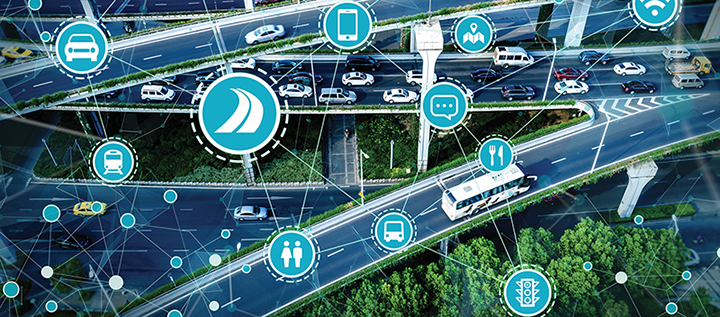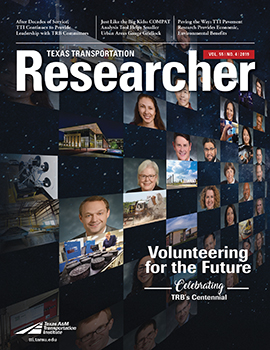AV-CV Strategy Guide Designed for Public Decision Makers
The required public transportation project delivery process can be slow, methodical and risk averse. The technology industry, by contrast, moves quickly, often takes risks, and may treat failures as learning moments. It’s hard to imagine a greater potential for culture clash, but those are the players in the game of advancing automated and connected vehicle (AV-CV) technology.

Consequently, public officials can find themselves caught between a desire to encourage innovation and economic growth while also remaining good stewards of public funds and ensuring public safety. Elected leaders saddled with that balancing act can use all the help they can get. And they can find it in Strategies to Advance Automated and Connected Vehicles, a briefing document produced through a National Cooperative Highway Research Project study and conducted by the Texas A&M Transportation Institute (TTI).
“The AV-CV benefits to consumers are potentially immense, but what about society writ large?” asks Ginger Goodin, TTI senior research engineer and Regents Fellow and report co-author. “We are only beginning to understand the extent to which these technologies might pose risks to public safety, security, health and social equity.”
Strategies outlined in the briefing document are designed to inform public policy decisions that can shape technology deployment in ways that advance societal benefits while mitigating potentially harmful unintended consequences. Each strategy addresses one of four desired outcomes:
- mitigating safety risks,
- encouraging shared automated vehicle use,
- addressing liability issues, and
- influencing market demand.
In their work, researchers applied concepts of social welfare economics — the means and methods of encouraging the well-being of both individuals and society as a whole. For example, consumers might be unwilling to pay for expensive technology if they perceive that much of the benefit would accrue to other people, and manufacturers would consequently be discouraged from building and selling AVs and CVs. To ensure societal benefits, governments might impose regulations or taxes that would compel the market to account for costs that in the past they wouldn’t have considered. This approach may require unconventional thinking for public officials.

“The transportation community can choose to wait and react,” says report co-author and TTI Senior Research Scientist Johanna Zmud. “Or decision makers can reframe the conventional public-policy discussion to responsibly and assertively advance AV-CV technologies in light of social interests, adopting the principles of rapid learning and shared knowledge creation.”
The report is highlighted in an American Association of State Highway and Transportation Officials’ YouTube video, TTV Special Report: Automated Vehicles in American — Managing the Risks and Rewards.
How Smart Is That Airport Restroom?
Internet of Things Applications Could Span Multiple Aspects of Air Travel
Airports, like any commercial enterprise, demand efficiency. So it’s only natural to expect that the Internet of Things (IoT) — that gigantic network of interconnected devices collecting and sharing data to merge the physical and digital worlds — could likely prove invaluable to helping airports achieve top-notch operations. The big question is how.

To find the answer, researchers at the Texas A&M Transportation Institute (TTI) and Deloitte Consulting, LLP, recently explored how IoT could be used in the airport environment. The study was sponsored by the Airport Cooperative Research Program (ACRP) of the Transportation Research Board and involved a stakeholder survey and interviews along with case studies and a literature review.
“Many technology applications are in play in airports today, like those that allow scanning your ticket or phone at a kiosk, finding your way in the airport using an app on your phone, or looking at a screen to find your gate,” explains TTI Senior Research Scientist Johanna Zmud, lead author on the study report. “But putting these technologies all together requires an infrastructure that lets these advanced services talk to each other seamlessly.”
Ultimately, the benefits promised by IoT applications fall into three categories: better operational efficiency, strategic differentiation (to create a better experience for travelers as well as other stakeholders including carriers, vendors and communities), and added revenue (through either existing or new customer relationships).

IoT integrations might include detailed functions like check-in, security clearance and baggage identification. Or they might involve things on the low-tech end, like equipping restrooms with sensors on faucets, toilets, and soap and paper dispensers that transmit data to alert managers about product shortages and facility breakdowns. The IoT extensions could also reach to airport tarmacs, where robots and autonomous vehicles might deliver baggage, fuel planes, clear debris, and perform other tasks.
“Airport operators and their stakeholders can use this primer to better understand the IoT environment and plan for implementing different strategies,” notes Marci Greenberger, acting manager of ACRP.
